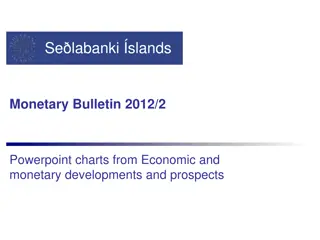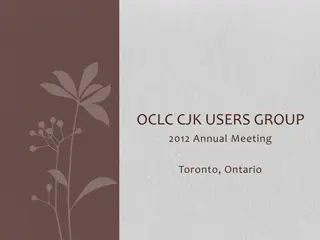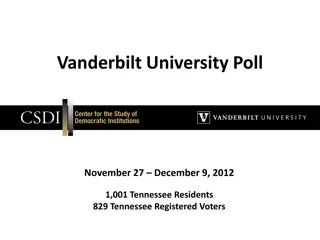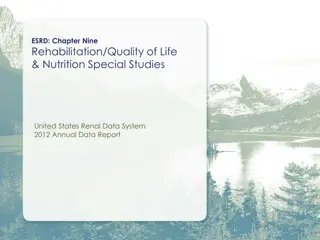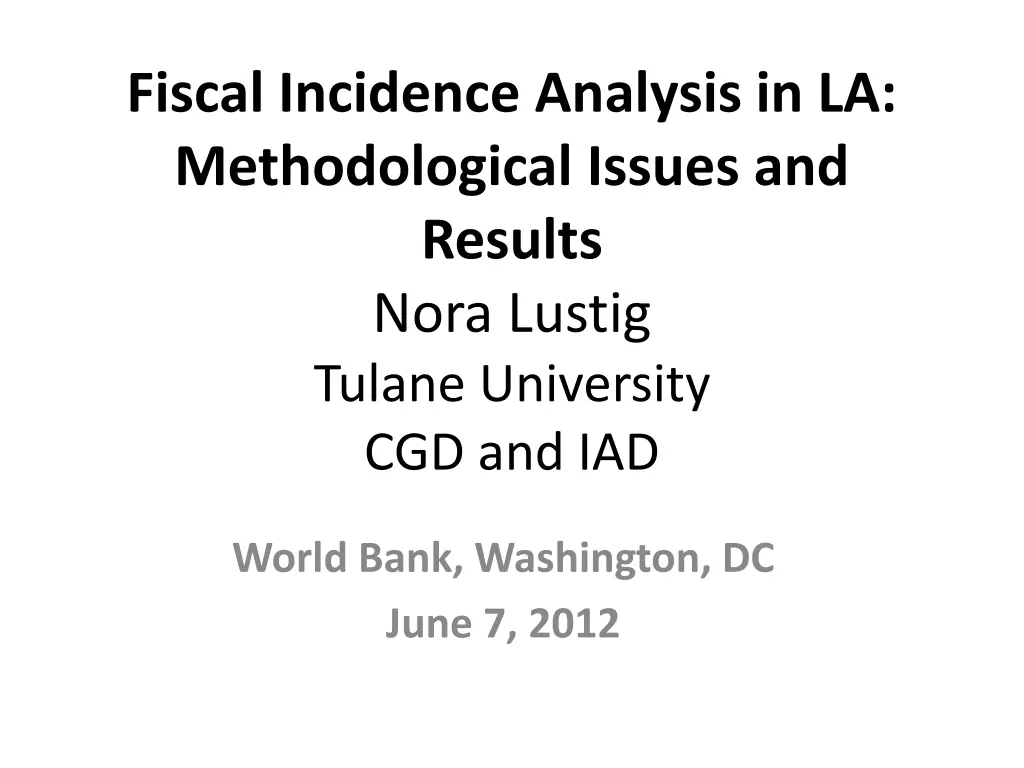
Fiscal Incidence Analysis in Latin America: Methodological Insights
Explore methodological issues and results of fiscal incidence analysis in Latin America, focusing on income concepts, inequality, poverty, and public spending. Learn about the Commitment to Equity (CEQ) project and the step-by-step process involved in this analysis.
Download Presentation

Please find below an Image/Link to download the presentation.
The content on the website is provided AS IS for your information and personal use only. It may not be sold, licensed, or shared on other websites without obtaining consent from the author. If you encounter any issues during the download, it is possible that the publisher has removed the file from their server.
You are allowed to download the files provided on this website for personal or commercial use, subject to the condition that they are used lawfully. All files are the property of their respective owners.
The content on the website is provided AS IS for your information and personal use only. It may not be sold, licensed, or shared on other websites without obtaining consent from the author.
E N D
Presentation Transcript
Fiscal Incidence Analysis in LA: Methodological Issues and Results Nora Lustig Tulane University CGD and IAD World Bank, Washington, DC June 7, 2012
Commitment to Equity (CEQ) Project Inter-American Dialogue and Tulane University s CIPR and Dept. of Economics. Currently: 12 countries 6 finished: Argentina (2009), Bolivia (2007), Brazil (2009), Mexico (2008), Peru (2009) and Uruguay (year of HH survey) 6 in progress: Chile, Colombia, Costa Rica, El Salvador, Guatemala, Paraguay
Fiscal Incidence: Plain vanilla case No modeling: No behavioral responses (or almost none) No inter-temporal dimensions No general equilibrium effects No fiscal sustainability analysis Welfare Indicator: Income per capita No adjustment for age, gender or economies of scale No adjustment for under-reporting Several household surveys in LA only have income data; so, if one wants to compare across countries, income data must be used in all, even in those in which there is data on consumption. But, for the latter, ideally one should do both.
Fiscal Incidence Analysis: Step by Step Definition of Income Concepts Construction of Income Concepts: calculating taxes & transfers for each household; decile/quintile Indicators: Changes in inequality and poverty Incidence by decile/quintile Concentration shares by decile/quintile Kakwani and Reynolds Smolensky Leakages and Coverage Per capita transfers Probit of excluded Fiscal mobility (transition) matrices
Methodological Issues Under-reporting especially at the top Households with zero incomes (follow SEDLAC) Defining Income Concepts: What is Market Income? Calculating taxes and transfers at the household level; deciles/ quintiles, ok to mix? Ranking issues; if only net market income available, should HH always be ranked by it? Scaling-up issues Imputing in-kind public spending
Adding the top; Greater Bs. As., Argentina (Alvaredo and Piketty en L pez-Calva y Lustig, 2010) 0.65 0.60 G(2) 0.55 G(1) 0.50 G* 0.45 0.40 0.35 0.30 1980 1982 1984 1986 1988 1990 1992 1994 1996 1998 2000 2002 2004 FIGURE 6 Gini coefficient in the Greater Buenos Aires 1980-2004 Notes: The black triangle denotes the Gini coefficient G* of individual income based on the Greater Buenos Aires household survey, own calculations. Database for 1983 is missing. All results correspond to October surveys, except for 2003 (May). Only income earners with positive income were considered and no further adjustments were applied. The white triangle denotes the Gini coefficient G(1) S+(1-S)G*, where S is the estimate of the top 0.1% income share from Alvaredo (2010). The white diamond denotes the Gini coefficient G(2) S+(1-S)G*, where S is the estimate of the top 1% income share from Alvaredo (2010). 7
Methodological Issues Under-reporting especially at the top Households with zero incomes (follow SEDLAC) Defining Income Concepts: What is Market Income? Calculating taxes and transfers at the household level; deciles/ quintiles, ok to mix? Ranking issues; if only net market income available, should HH always be ranked by it? Scaling-up issues Imputing in-kind public spending
What is market income? In addition to the uncontroversial wages and salaries, income from capital and private transfers (e.g., remittances), what about these: Incomes from sales of durables Auto-consumption Imputed rent for owner s occupied housing Contributory pensions from individualized accounts Contributory pensions from social security
Commitment to Equity Project Incomes from sales of durables/NO Capital Gains/NO Auto-consumption/YES Imputed rent for owner s occupied housing/YES Alimony, Inheritance and Gifts ??? Contributory pensions from individualized accounts/YES Contributory pensions from social security: Benchmark: YES Sensitivity Analysis: NO
What is Net Market Income? Market Income minus Direct Taxes and Contributions to Social Security (Payroll Taxes) But, contributions to social security: Benchmark: contributions going to pension, are NOT subtracted; all the other contributions are Sensitivity Analysis: all contributions to social security are subtracted
Methodological Issues Under-reporting especially at the top Households with zero incomes (follow SEDLAC) Defining Income Concepts: What is Market Income? Construction of income concepts/Calculating taxes and transfers at the household level; deciles/ quintiles, ok to mix? Ranking issues; if only net market income available, should HH always be ranked by it? Scaling-up issues; totals from public accounts by tax category/program; only for inequality and incidence Imputing in-kind public spending: education, health; public goods (e.g., infrastructure)?
Construction of Income Concepts/Calculating Taxes & Transfers Unfortunately, it is not possible to construct income concepts directly from household surveys Household Surveys in LA are quite heterogeneous: Some report income and not consumption Some do not report autoconsumption Some do not report owner s occupied housing rent; they do not have the information to run hedonic regressions
Construction of Income Concepts/Calculating Taxes & Transfers Even more importantly: Not clear if reported income is before or after taxes. SEDLAC database assumes that employees income is net of taxes and contributions to social security and self-employment and capital incomes are before taxes and transfers Not always clear if people include government transfers in the income they report (which we usually take as market income)
Construction of Income Concepts/Calculating Taxes & Transfers Data on direct taxes, contributions to social security, government transfers, consumption (for indirect taxes and subsidies), use of government health services may be imperfectly captured or not captured at all
Options to Construct Income Concepts Direct Identification Method Inference Method Simulation Method Imputation Method Alternate Survey Secondary Sources Method
How sensitive are results to the placement of contributory pensions? Brazil vs. Mexico
How sensitive to placement of contributory pensions: Uruguay incidence Figure? 4? -? Changes? in? Income? by? Decile CHANGES? IN? DISPOSABLE? INCOME CHANGES? IN? POST-FISCAL? INCOME CHANGES? IN? FINAL? INCOME Source:? authors'? calculations? based? on? Encuesta? Continua? de? Hogares? (2009)? and? Nat.? Accts. Notes: For? definition? of? income? concepts? see? text.? Benchmark:? contributory? pensions? are? included? in? market? income. Sensitivity:? contributory? pensions? are? treated? as? government? transfers.
How sensitive to placement of contributory pensions: Uruguay concentration shares CCTs
Main Questions Income vs. Consumption; either or , or both ? How to deal with under-reporting at the top? Use tax returns data (Alvaredo for Colombia) What should be included under market income? How should owner s occupied imputed rent be estimated? (we used 10% of mket. Income) Contributory pensions; with and without , other alternatives?
Main Questions Mixing methods to estimate taxes and transfers; e.g., at household level with decile info; acceptable? Ranking by which income concept? problem of heterogeneous surveys Scaling-up: category by category? Full amounts in public accounts? How to take into account tax evasion? direct taxes; indirect taxes
Main Questions How should in-kind government transfers be calculated? Education Health Public goods: e.g., roads; sewage and sanitation; etc.
Main Questions Absence of Conventions on Progressiveness/Regressiveness
Main Questions Modeling: Behavioral responses: consumption and labor supply Inter-temporal effects General Equilibrium Effects Fiscal Sustainability
Main Questions Costing Opportunities for All : -Plain Vanilla case: CEQ calculates gaps straightforwardly (without scaling-up for income poverty measures) -Will apply Cuesta s approach
References Lustig, N. Commitment to Equity Assessment (CEQ): A Diagnostic Framework to Assess Governments Fiscal Policies Handbook, Tulane Economics Department Working Paper 1119 and CIPR (Center for Inter-American Policy & Research) Working Paper, New Orleans, Louisiana, April 2011. http://ideas.repec.org/p/tul/wpaper/1119.html and http://cipr.tulane.edu/articles/detail/804/Workin g-Document-Commitment-to-Equity-CEQ- Handbook
References Lustig, Nora (coordinator). Fiscal Policy and Income Redistribution in Latin America: Challenging the Conventional Wisdom, Argentina: Carola Pessino; Bolivia: George Gray Molina, Wilson Jimenez, Ver nica Paz, Ernesto Ya ez; Brazil: Claudiney Pereira, Sean Higgins; Mexico: John Scott; Peru: Miguel Jaramillo. , Economics Department, Tulane University, Working Paper. 2011. Revised: Forthcoming.
References Lustig, N. and S. Higgins. Fiscal Incidence, Fiscal Mobility and the Poor: a New Approach. Economics Department, Tulane University, Working Paper. 2012. Bucheli, M., N. Lustig, M. Rossi and F. Amabile Social Spending, Taxes and Income Redistribution in Uruguay. Economics Department, Tulane University, Working Paper. Forthcoming.













